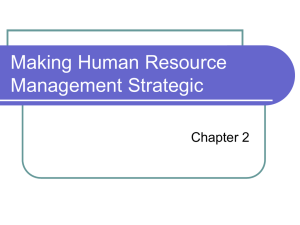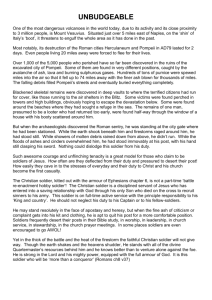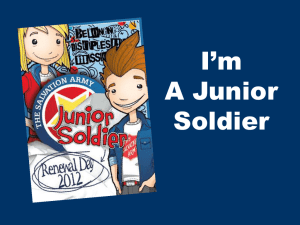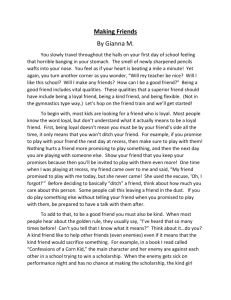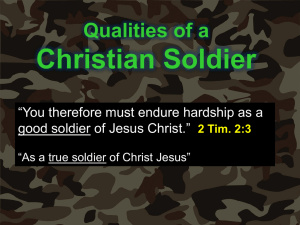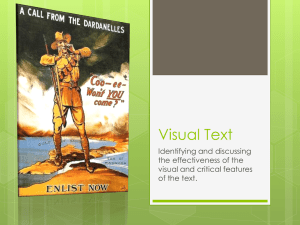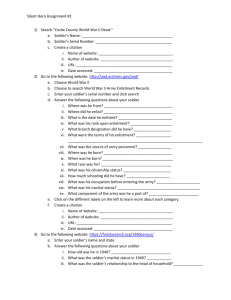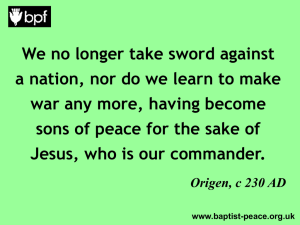Art Therapy/Trauma
advertisement
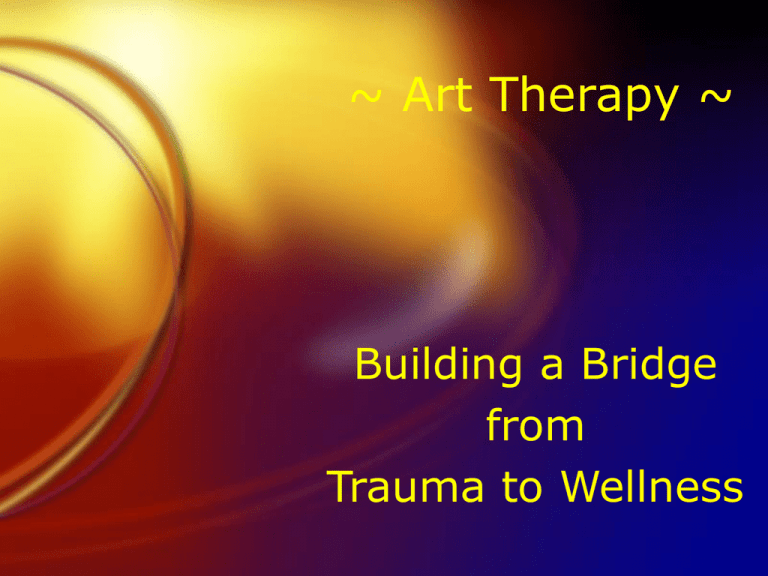
~ Art Therapy ~ Building a Bridge from Trauma to Wellness Art Therapy makes the unconscious conscious. It builds _…a bridge…_ between the internal and the external worlds. Art Therapy aims: • to create circumstances through which healing can occur using art. • to heal by creating pathways into the worlds of individuals and groups which allow them to map and dialogue with aspects of themselves and their world using art. • to heal by setting up conditions which facilitate the bridging of worlds so that healing occurs through the transcendence of alienation – self-alienation and social alienation. • to facilitate self-realisation which moves people towards a higher level of functioning in which their resources and potentials are recognised and integrated. • to create growth, personal power and meaning. • to facilitate soul work wherein the principles which vitalise us and assist our living fully are discovered, engaged and expressed. Art Therapy enhances: Mindfulness Recognition of process Sensory and psychological integration Perspective Mind/body connection Self-esteem Trust in self The creative imagination Pattern recognition It slows time It connects time and place Art Therapy diminishes: Stress Helplessness [especially learned helplessness] Hopelessness Depression Anxiety Confusion Art Therapy and Trauma Art Therapy has been used effectively in working with: • • • • • • Victims of natural disasters Victims of war Refugees War veterans suffering PTSD Victims of domestic violence Cancer patients Despair = Suffering without Meaning Victor Frankel Art Therapy is a means to enable people to find meaning in their suffering. It helps them to see and to tell their story from a place of deeper understanding. Art Therapy reveals what we don’t know we don’t know. “We carry within us the wonders we seek without; there is all Africa and her prodigies in us.” Carl Gustav Jung Art Therapy and Resilience Definition: the ability to recoil or spring back into shape after bending, stretching, or being compressed; the ability to withstand or recover quickly from difficult conditions. Resiliency Traits: Optimistic, responsible, creative, synergistic, professional, quick learner, flexible, self-motivated [www.ResiliencyCenter.com] How to use Art Therapy in developing these traits? Art Therapy and the Brain Research conducted by Christopher Belkofer, an art therapist, and Lukasz Konopka, a neuroscientist, at Hines Veteran’s Hospital in Illinois, used an EEG to show differences in the patterns of electrical activity of a participant’s brain following one hour of painting and drawing. Art Therapy and Memory Eric Kandel, an Austrian psychiatrist, discovered that the emotional charge of a fearful or anxious memory in the amygdala is lessened when that memory becomes conscious. Bringing the unconscious into conscious awareness helps dissipate the intense emotional charge around it. Art Therapy enables this to happen in a particularly effective way. Art Therapy and Hurricane Katrina One of the most common images in children’s art is the house: a square topped by a pointy roof, doors and windows. Art therapists noticed that for many of the young victims of Hurricane Katrina, the house had morphed into a triangle. They realized the internal schema of these children had changed. They weren’t drawing the house as a place of safety, they were drawing the roof rising above the water line. Over time, as the children healed, their drawings returned to the box and pointy roof design. Art Therapy exercises: Scribble drawings Public Face/Private Face Waking Up to Emotions The Heroic Journey The Loyal Soldier The Room Where All Is Always Well Fear ‘Fear has a large shadow but he himself is quite small. He has a vivid imagination. He composes horror music in the middle of the night. He is not very social and he keeps to himself at political meetings. His past is a mystery. He warned us not to talk to each other about him, adding that there is nowhere any of us could go where he wouldn’t hear us. We were quiet. When we began to talk to each other, he changed. His manners started to seem pompous and his snarling voice sounded rehearsed. Two dragons guard Fear’s mansion. One is ceramic and Chinese. The other is real. If you make it past the dragons and speak to him close up, it is amazing to see how fragile he is. He will try to tell you stories. Be aware. He is a master of disguises and illusions. Fear almost convinced me that he was a puppet-maker and I his marionette. Speak out boldly, look him in the eye. Startle him. Don’t give up. Win his respect and he will never bother you with small matters.’ J. Ruth Gendler, The Qualities. The Heroic Journey 1. A place, time and characters are described – as normal, settled, peaceful, in good order. 2. Then crisis occurs [a giant, a plague, a witch, a flood, a cyclone, a tsunami, etc.] 3. A descent, a collapse of the previous reality. Metaphorically – the falling/the fall, being lost, darkness, ignorance, heaviness, illness, chaos. 4. Nadir – until ultimate chaos and even death [bodily and/or spiritually] may occur. 5. A turning point where guidance is given, power returns, gifts are received. 6. Discovery of the pathway to return or renewal – rising, finding the way, illumination, knowledge, gnosis, lightness, health/well-being, order. 7. The world returns to its original order or a new order is created. The Heroic Journey Permits the recognition of alchemical transformation - turning base metals into gold. Recognition of the Nadir when the only way is up - as not only the Void but as a place of potential transformation, can act as a shield against suicidal impulses. Seeing trauma as a process - i.e. as inherently containing movement, as something through which one moves - allows a sense of ongoingness rather than reaching a dead end. It can enable a sense of psychological/ symbolic death and rebirth. Jo’s Heroic Journey The Loyal Soldier The Loyal Soldier is a psychological construct developed by Bill Plotkin. It is 'a courageous, wise, and stubborn subpersonality that formed during our childhood and created a variety of strategies to help us survive the realities (often dysfunctional) of our families and culture. It keeps us “safe” by making us small or limited, or by further traumatizing us. It is the intrapsychic element that shovels chunks of our wholeness into our Shadow so that we will appear acceptable or invisible to the powers that be.' It’s usually - but not necessarily - in childhood that we draw up barriers/barricades to protect us. Can you remember when the Loyal Soldier came into your life and protected you? When you shut down? How does that impact on your life now even though the danger is past? The Loyal Soldier can be seen as useful or not useful depending on the situation -> being able to discriminate, discern rather than it being an automatic knee-jerk reaction over which you have no control. Jo’s Loyal Soldier ~ Thank You ~ Karen Adler Dip. Transpersonal Art Therapy Grad. Dip. Material Anthropology Email: karenadler222@gmail.com PH: 0420 593 121
